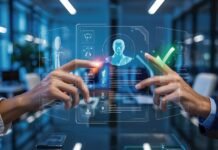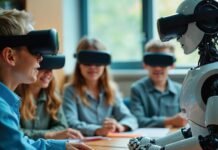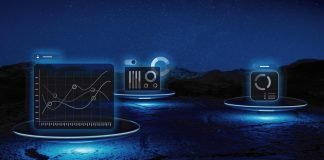Today’s human resources technology exceeds traditional process streamlining since it fundamentally changes how organizations manage their workforce. The pace of industrial digital transformation creates a gap between outdated talent strategies and changing business needs. The goal of efficiency has moved to the background while organizations recognize success through adaptability and human-AI teamwork, along with agility.
The essential inquiry remains unclear because HR innovations today generate enduring workforce development or alleviate momentary process weaknesses. In 2025, business executives need to transition from current HR approaches, which react to market changes, and establish advanced workforce development systems for the future.
Table of Contents:
1. Automation’s Promise vs. The Hidden Cost of Efficiency
2. Beyond Data-Driven HR—Why Context Matters More Than Ever
3. The Quiet War for Talent: Reskilling vs. Hiring in a Post-Digital Age
4. AI-Powered HR Without Ethical Blind Spots—Is It Possible?
5. The End of Employee Experience as We Know It
Closing Argument: The Future C-Suite Imperative in Workforce Tech
1. Automation’s Promise vs. The Hidden Cost of Efficiency
The productivity revolution unlocked through AI-driven workforce automation produces fascinating results, yet it must carefully examine its organizational cost. The convenience of immediate workplace efficiency gains through automation advances comes at the expense of human proposition skill development and staff trust in company operations.
A 2024 McKinsey report showed 70% of top executives identified workforce automation as their main goal, yet 49% of them recognized potential negative effects from this trend, which might lead to skill regression along with reduced worker involvement. The appropriate answer does not involve slowing down automation because it requires the development of a hybrid system that combines AI operational speed with human creative potential.
Companies that lead this transition are creating a new way to use automation in their operations. The application of AI does not replace human positions because it enhances workforce capabilities and aids in crucial decisions, and provides individualized employee support. The organizations that achieve perfect algorithm-human collaboration will dominate future workforce development.
2. Beyond Data-Driven HR—Why Context Matters More Than Ever
The human resources industry experiences advanced transformation through AI-based hiring models combined with predictive analytics systems, which, however, have specific constraints. The power of data lies in precision, but context acts as the determinant for creating the proper strategy. Solid decisions based on data could deteriorate when humans and their characteristics are overlooked in preference for numbers alone. This results in regions of weak choice-making and programmed prejudice.
Take hiring, for example. The MIT Sloan Management Review conducted research that demonstrated that recruitment systems using AI tend to keep previous biases active instead of getting rid of them through training methods based on historical data. By 2025, the clear transition will occur where HR technology enables real-time assessment of economic factors together with worker feelings and staff behavioral patterns to drive optimal decision-making.
3. The Quiet War for Talent: Reskilling vs. Hiring in a Post-Digital Age
Business executives must decide between long-term reskilling initiatives or continuing to choose external candidates first. Time-based training methods have lost their ability to deliver modern skills in today’s fast-evolving business environment. Modern employees express zero interest in traditional static training methods in favor of tailored paths for their career growth.
Two examples from Unilever and Amazon demonstrate the growth of internal talent marketplaces. Employees need a way to change roles based on business requirements. By 2025, the most accomplished organizations will run as skill ecosystems rather than traditional rigid hierarchies because these systems are flexible, adaptable, and prioritize employee internal movements.
4. AI-Powered HR Without Ethical Blind Spots—Is It Possible?
The future of HR involves artificial intelligence due to its critical crossroads in boardroom discussions. Problems of ethics continue to prevent organizations from adopting AI in large numbers. The HR technology ecosystem should employ complete transparency and accessible reasoning capabilities while integrating human monitoring for all systems.
Regulatory modifications have defining effects on the current situation. When the European Union’s AI Act has its final word in 2025, it will enforce strict compliance requirements for AI decisions used in hiring and workforce analytics. Organizations not meeting the updated standards face possible legal charges and damage to their reputation.
The way forward? Responsible automation helps organizations achieve ethical AI usage together with quantifiable business outcomes. Organizations should develop HR governance frameworks that combine explanations of AI systems with system bias testing as well as employee participation in AI-based decisions.
5. The End of Employee Experience as We Know It
Employees experience fundamental changes in their work environment. Organizations must now organize their workforce design based on hybrid work models instead of viewing them as special arrangements. The year 2025 will introduce workplace digital experiences that provide an Amazon-like user experience quality to HR technology interfaces.
Organizations that use AI to create highly personalized digital platforms for employees obtain higher staff retention as well as higher levels of engagement. Employee satisfaction rates rose by 35% when organizations applied AI personalization techniques to their employee engagement practices, according to a 2024 Gartner analysis.
Every company now needs to understand that a strictly standardized approach to employee engagement no longer works. Companies that develop autonomous work experiences along with personalization features and Artificial Intelligence superiority will define the workplace of the future.
Closing Argument: The Future C-Suite Imperative in Workforce Tech
Workforce efficiency faces its biggest threat from organizational leadership rather than from a deficit in available technology. HR technology innovations reach their maximum effectiveness through the proper leadership approaches they receive.
The 2025 workplace will emerge under leadership that focuses on the following three aspects:
- Move beyond process automation and towards workforce transformation
- Balance AI-driven efficiency with human-centric workforce strategies
- Organizations should redesign their talent strategies with adaptability and contextual applicability, and future-oriented design principles
Leadership teams who welcome transformation and innovation will fashion the upcoming workplace environment.
Explore Hrtech Articles for the latest Tech Trends in Human Resources Technology












